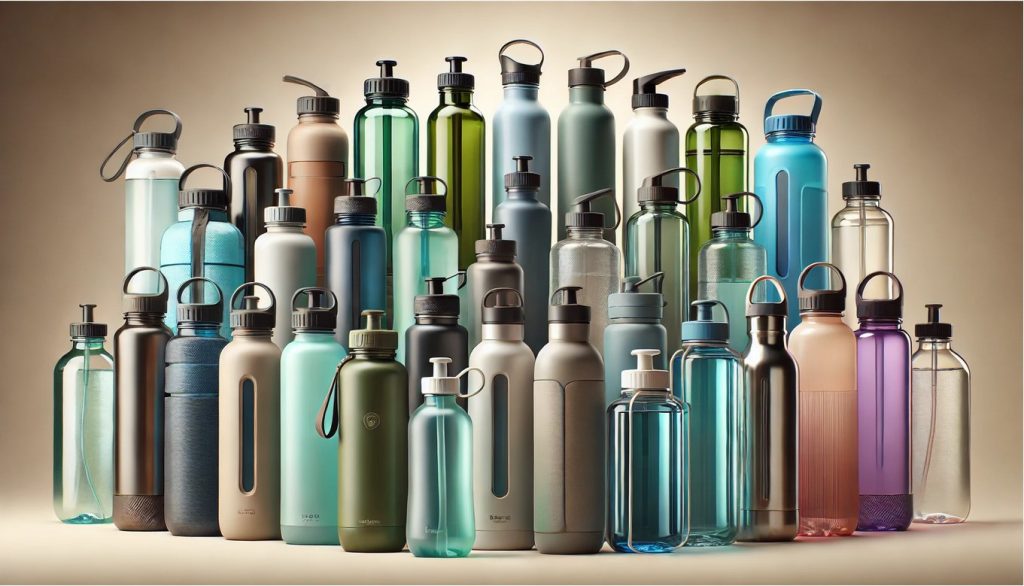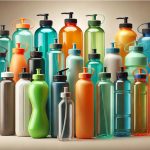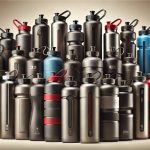When embarking on a hiking adventure, one of the most important considerations is staying hydrated. Carrying enough water without being weighed down is essential for long treks, and lightweight hiking bottles offer the perfect solution for hikers who need to balance hydration with pack weight.
Importance of a Lightweight Hiking Bottle
When you’re hiking, every ounce matters. The less weight you carry, the easier it will be to enjoy your hike, especially on long or strenuous treks. A lightweight hiking bottle can make a significant difference in reducing the overall weight of your gear while ensuring you have enough water to stay hydrated. Additionally, a well-designed, easy-to-carry bottle will improve convenience and accessibility during your hike, allowing you to easily take a sip while on the move.
Benefits of a Lightweight Hiking Bottle
- Reduced Pack Weight: Lightweight bottles help you carry less weight, which is essential for reducing fatigue during long hikes.
- Easy to Carry: Many bottles are designed with features like carabiner loops or ergonomic shapes that make them easy to attach to your backpack or carry in your hand.
- Convenient Hydration: Accessing your water quickly is vital during a hike, and lightweight bottles often come with easy-to-use spouts or straws.
- Durable Design: Despite being lightweight, many modern hiking bottles are made of durable materials that can withstand drops, rough handling, and extreme temperatures.
Types of Lightweight Hiking Bottles
There are several types of lightweight hiking bottles available, each designed with different uses and preferences in mind. Whether you prefer a traditional bottle design, a hydration reservoir, or a collapsible option, it’s important to know the differences so you can make an informed choice.
Traditional Water Bottles
Traditional water bottles are the most common and recognizable type of water container for hikers. Typically, these bottles are made of materials like plastic, stainless steel, or aluminum, and they come in various sizes and designs to suit different needs.
Features of Traditional Water Bottles
- Simplicity: Traditional bottles are often the simplest design, with a screw-on cap or flip-top lid for easy access.
- Variety of Sizes: These bottles are available in a wide range of sizes, from small 500ml bottles to larger 1-liter or 1.5-liter options.
- Ease of Use: Traditional water bottles are easy to use, requiring minimal effort to open and close the lid. They are often spill-proof, especially when compared to other bottle types.
Popular Materials for Traditional Bottles
- Plastic: Plastic bottles are the most lightweight option and are available in many designs. However, it’s important to look for BPA-free plastic to avoid harmful chemicals leaching into your water.
- Stainless Steel: Stainless steel bottles are durable and often insulated to keep water cold for longer periods. They tend to be heavier than plastic bottles but are much more durable.
- Aluminum: Aluminum bottles offer a balance between weight and durability. However, they are often lined with a coating to prevent the metal from affecting the taste of the water.
Common Uses of Traditional Water Bottles
- Short-Day Hikes: For day hikes or short trails, traditional water bottles are usually sufficient to carry enough water for the journey.
- Casual Walks and Outdoor Activities: These bottles are also ideal for casual outdoor activities like picnics, walks, or short outdoor excursions.
Hydration Reservoirs (Bladders)
Hydration reservoirs, or bladders, are flexible water containers often used by hikers, bikers, and runners. These are designed to be carried in a backpack and allow for hands-free hydration via a hose or straw. Hydration bladders are popular for long hikes or runs because they enable you to drink without having to stop or take your hands off your trekking poles.
Features of Hydration Reservoirs
- Hands-Free Hydration: With a tube or straw, you can drink water while keeping your hands on your trekking poles or maintaining your focus on the trail ahead.
- Integrated Design: Hydration bladders are designed to fit into the hydration sleeve of most hiking backpacks, meaning you don’t have to carry an additional water bottle in your hands.
- Flexible and Compact: Bladders are made of flexible materials that can collapse as they empty, which helps reduce the weight and bulk in your pack.
Popular Materials for Hydration Reservoirs
- Polyurethane (PU): Most hydration reservoirs are made of flexible polyurethane, which is lightweight, durable, and resistant to cracking.
- Thermoplastic Elastomer (TPE): Some higher-end hydration bladders are made from TPE, which is BPA-free, more resistant to bacteria, and less prone to cracking in extreme temperatures.
Common Uses of Hydration Reservoirs
- Longer Hikes: Hydration reservoirs are perfect for long, strenuous hikes where constant access to water is needed.
- Cycling and Running: Because hydration bladders allow for hands-free drinking, they are commonly used by cyclists and runners who need to stay hydrated without pausing.
- Multi-Day Treks: If you’re hiking for multiple days, a bladder system can provide a steady supply of water throughout your journey.
Collapsible Water Bottles
Collapsible water bottles offer hikers the flexibility of a full-sized water bottle when needed, with the added benefit of being able to collapse down to a fraction of their size when empty. These bottles are perfect for minimizing pack space during multi-day trips or when you don’t want to carry a full-sized bottle at all times.
Features of Collapsible Water Bottles
- Compact Storage: Once emptied, collapsible bottles fold down to a compact size that can be easily tucked into a bag or even a pocket.
- Flexibility: Made from soft materials, these bottles bend and fold without cracking, making them durable for long-term use.
- Lightweight: Collapsible bottles are often lighter than traditional bottles, which is ideal for hikers who need to minimize pack weight.
Popular Materials for Collapsible Bottles
- Silicone: Most collapsible bottles are made from food-grade silicone, which is flexible, durable, and lightweight. Silicone is also resistant to bacteria and odors.
- Polyethylene: Some collapsible bottles are made from soft plastic materials, but these may not be as durable as silicone.
Common Uses of Collapsible Water Bottles
- Multi-Day Hiking: These bottles are ideal for multi-day hikes, where the need for water may be less frequent, but saving space in your pack is a priority.
- Traveling: Collapsible bottles are useful for travelers who want to avoid carrying a large, full-sized water bottle during sightseeing or in crowded areas.
Materials Used in Lightweight Hiking Bottles
When selecting a hiking bottle, the material it’s made from plays a significant role in determining its weight, durability, and safety. The right material can help ensure that your bottle lasts through numerous trips, while also keeping your water clean and tasting fresh.
Plastic Bottles
Plastic is one of the most common materials used in lightweight hiking bottles. There are many different types of plastic, each with its own benefits and drawbacks.
Benefits of Plastic Bottles
- Lightweight: Plastic bottles are extremely lightweight, making them ideal for hikers looking to reduce pack weight.
- Affordable: Plastic bottles tend to be more affordable than bottles made from other materials like stainless steel or aluminum.
- Variety of Designs: Plastic bottles are available in many different sizes, shapes, and designs, allowing hikers to choose the best option for their needs.
Drawbacks of Plastic Bottles
- Durability Issues: Over time, plastic bottles can crack or become scratched, which may affect their integrity.
- BPA Concerns: Many plastic bottles may contain BPA (bisphenol-A), a chemical that can leach into water and cause health problems. It’s essential to choose BPA-free plastic bottles to avoid these risks.
Stainless Steel Bottles
Stainless steel is a highly durable material that’s commonly used in hiking bottles. While it’s heavier than plastic, it offers superior performance in terms of temperature retention and long-term durability.
Benefits of Stainless Steel Bottles
- Durable: Stainless steel is resistant to dents, cracks, and corrosion, making it ideal for outdoor use.
- Non-Toxic: Unlike some plastics, stainless steel does not leach harmful chemicals into water, making it safer for long-term use.
- Temperature Retention: Many stainless steel bottles come with insulation, which helps keep your water cold during hot hikes and warm during cold weather.
Drawbacks of Stainless Steel Bottles
- Weight: Stainless steel is heavier than plastic, which can increase the overall weight of your pack.
- Cost: Stainless steel bottles tend to be more expensive than plastic bottles, especially those with insulation.
Silicone Bottles
Silicone bottles are a more flexible and lightweight option that’s gaining popularity among hikers. These bottles are often used for collapsible designs due to their ability to compress down without damaging the material.
Benefits of Silicone Bottles
- Flexible: Silicone bottles can be collapsed, rolled, or folded when not in use, saving significant space in your pack.
- Non-Toxic: Silicone is a food-safe material, free from BPA and other harmful chemicals commonly found in plastics.
- Lightweight: Silicone bottles are generally lighter than stainless steel, making them a good compromise between plastic and metal bottles.
Drawbacks of Silicone Bottles
- Durability: While silicone is quite flexible, it may not be as durable as stainless steel in terms of withstanding heavy impacts or extreme conditions.
- Odor Retention: Silicone can sometimes retain odors, especially if not cleaned properly after each use.
Factors to Consider When Choosing a Lightweight Hiking Bottle
Choosing the best lightweight hiking bottle requires careful consideration of several factors that can impact its usability, durability, and suitability for your needs.
Size and Capacity
The size and capacity of your hiking bottle depend on the length of your hike and your hydration needs. For short day hikes, a bottle with a capacity of 500 ml to 1 liter should suffice. However, for longer hikes or multi-day adventures, a larger bottle or hydration bladder with a capacity of 2 liters or more may be necessary.
Portability and Ease of Use
Consider how easy the bottle is to carry. Lightweight bottles should have features such as carry loops, ergonomic shapes, or even the ability to be clipped to a backpack for easy access. Also, consider how easy it is to drink from the bottle, whether it’s through a traditional screw cap, a flip lid, or a built-in straw.
Durability
Durability is crucial when choosing a hiking bottle. You’ll want a bottle that can withstand bumps, drops, and rough handling without cracking or leaking. Materials like stainless steel and silicone offer better durability compared to plastic, though they may come with added weight.
Insulation
If you’re hiking in extreme temperatures, insulation can be an important factor to consider. Insulated bottles can keep your water cold on hot days or prevent freezing in cold environments. Double-walled stainless steel bottles offer the best insulation, keeping liquids cold for extended periods.
Cleaning and Maintenance
Hiking bottles need to be cleaned regularly to avoid the buildup of bacteria and odors. Bottles with wide mouths are generally easier to clean, as you can access the interior more easily. Additionally, look for bottles that are dishwasher safe or come with removable straws or nozzles for easy cleaning.







